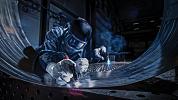Contributing Editor
- FMA
- The Fabricator
- FABTECH
- Canadian Metalworking
TRUMPF’s virtual INTECH event reveals the potential of today’s and tomorrow’s technologies
Advanced bending, joining tools can help reduce cost per part, while data drives ever-smarter machines
- By Dan Davis and Tim Heston
- May 18, 2021
- Article
- Automation and Software
It was fitting that on the first day of TRUMPF’s virtual INTECH 2021 customer event, during the “Driving Cost Out of Manufacturing” roundtable discussion, the focus was on a portable charcoal grill. While the concept of grilling up burgers and hot dogs in a stadium parking lot may have been foreign to those outside of North America, everyone certainly understood the importance of focusing on a fun outdoor activity after being cooped up because of the pandemic.
While the grills were meant to be a fun focal piece, the discussion had real relevance for metal fabricators in Canada, Mexico, and the U.S. Steel prices are near record highs, and many shops don’t have much wiggle room to pass along increased costs to their customers. That’s just the reality of these supply chain relationships.
But TRUMPF’s two-day event provided evidence that advanced fabricating technology can help metal fabricators during these unpredictable times, because strategic capital equipment investment can produce more efficient and responsive manufacturing results. Consider that simple charcoal grill.
The grill in the original design required laser cutting, bending on a press brake, and MIG welding. It called for sheet metal of three different thicknesses (0.04, 0.08, and 0.25 in.) and legs made of square tube. The full assembly comprised 17 parts not counting hardware.
“Based on this design and not trying to optimize the production costs, we’re looking at about $150 to produce this,” said Tom Bailey, a TRUMPF technical specialist.
So the conversation began. What could be done to reduce the product’s manufacturing cost? The end product was weld-intensive, so a welding cell, such as TRUMPF’s TruArc Weld 1000 automated cells, with a collaborative robot that can be programmed by simply moving the arm along the weld path, could take some labour costs out of the equation, even in a small-batch manufacturing scenario. If that was not a possibility, Bailey suggested taking another crack at the design.
The next version of the grill design focused on eliminating welding. All the parts were the same material thickness to simplify the bending process, and the number of parts in the assembly was reduced from 17 to 11. The tubular support legs were redesigned to be bent forms.
With no welding involved, the production costs fell on the bending department. Roundtable moderator Burke Doar, TRUMPF’s senior vice-president of sales and marketing, said that might prove difficult for those shops without an experienced press brake operator or an automated press brake cell to form the parts with little human involvement.
Masoud Harooni, TRUMPF’s welding product manager, offered up another design adjustment for the grill, but this time focusing on the premise that production was going to scale in the near term. The new adjustment called for some welding and some bending. By moving away from manual MIG welding to automated laser welding, Harooni was able to cut production costs dramatically. Assembling the grill with manual welding dropped the cost to $39.51, but the use of automated laser welding reduced overall welding costs to $16.62. Welding time with laser welding took just over three minutes, six times quicker than MIG welding, and laser welding resulted in minimal post-process finishing.
Even though the roundtable participants agreed that laser welding was ideal, they stressed that investment in other aspects of the production process, such as offline programming, bending automation, and arc welding automation, also could take a bite out of production costs. Metal fabricators have plenty of options to consider; they just need to find the right combination to meet current customer needs and possibly grow the business.

During TRUMPF’s virtual INTECH 2021 customer event, roundtable participants discussed the different ways that advanced fabricating technology can help a metal fabricator remove manufacturing cost from a design. In this case, the focus was a portable charcoal grill.
Felix Weigelt, Smart Factory consultant for TRUMPF, said Industry 4.0 technology is making the shop floor more flexible than was ever thought possible, even just 20 years ago. In his presentation, “Introducing Integrated Cutting and Bending Solutions,” Weigelt described how digital connectivity among front office software systems, laser cutting machines, bending machines, and the material storage and retrieval system is making a production batch of one feasible, even when it falls into much larger-value jobs.
“We’re using the increased data collected from these machines to optimize programs and processes,” he said.
One key point on those integrated cutting and bending solutions is the balancing of different production processes. In the typical job shop environment, advanced laser cutting machines, such as the TruLaser Center 7030, usually produce a variety of different parts that have different thicknesses and geometries. This variation usually leads to varying cutting and bending process times. With an integrated system, those processes can be balanced to ensure all machines run at maximum productivity and output—all without human intervention. These systems also can accommodate punching machines, combination machines, and automated bending cells. Weigelt stressed that those integrated cutting and bending systems represent a game-changer enabling fully autonomous lights-out production.
“You also can grow with this type of system, adding machines in any combination you want,” Weigelt said. Technology investment to resolve current-day production realities also holds the potential to be a foundation for keeping up with tomorrow’s challenges.
AI and Shops of the Future
What will the sheet metal shop of the future look like? Several presentations from this year’s virtual INTECH explored just how different the future fabricator could be.
“All workstations, machines from third parties, and everything else needs to be integrated. That is the central point of the future.” So said Dr. Jens Ottnad, head of R&D predevelopment networked systems, during a roundtable discussion about the smart factory.
“For this, data is key,” said Johannes Böttcher, head of product management services. “The data represents the basis for predictive and performance services.”
Manuel Schwestka, product management, fabrication and logistics software, explained how the right data “can show the complete process chain. And for certain activities, we need expertise from other partners.” He described one partnership in which fabrication production control software connects directly with an automated guided vehicle system. “This way, we know when and where a sheet is cut and bent, and when it needs to be further processed. [And the AGVs] bring it to the right workstation at the right time.”
The panel discussed the company’s Sorting Guide product, which aims to streamline manual part sorting. The artificial intelligence-based system mounts a camera above the offload table where it can view the completed cut nest and, via an adjacent screen, outline each part with a specific colour code to show the operator the sorting order.
On the surface, the act of part sorting after laser cutting looks straightforward, even mundane. But in truth, sorting can be a fabricator’s Achilles’ heel. A part lost or misplaced during sorting can wreak havoc on part flow downstream (such as having wrong parts routed toward the wrong processes) and produce the worst kind of waste: rework. A fab shop pays to make the part, then pays to make it again. A laser that can cut cleanly at incredible speeds won’t improve the bottom line if those perfectly cut parts are lost or misplaced.
Here, AI engines can help machines learn, improve, and perfect the overall process. Data from sorting can feed back to nesting.
AI has the ability to see patterns humans simply cannot, and the more data AI engines can access, the more powerful they can become—hence the importance of sharing data.
“From a digital point of view, we are witnessing a paradigm shift,” Ottnad said during the panel discussion. A machine might represent the state-of-the-art on the day it was delivered. Technological advancement moves on as the machine OEM introduces new and better machines. But in the fab shop, the advancements within a particular machine stop. Machines don’t get better over time.
Comprehensive data-sharing, Ottnad said, changes the paradigm. Machine development will happen not only at the machine OEM but also in the field, in fabrication shop floors across the globe. “Machines learn. They get better over time. And that happens with data, by the combination of data [from different sources]. From that, we develop new algorithms, which we can load into the machine. We get better and better with experience. We learn in the field, and this is something completely new.”
Editor-in-Chief Dan Davis can be reached at dand@thefabricator.com. Contributing Editor Tim Heston can be reached at timh@thefabricator.com.
TRUMPF Inc., www.trumpf.com
About the Authors

Tim Heston
2135 Point Blvd
Elgin, IL 60123
815-381-1314
subscribe now


Keep up to date with the latest news, events, and technology for all things metal from our pair of monthly magazines written specifically for Canadian manufacturers!
Start Your Free Subscription- Industry Events
Automate 2024
- May 6 - 9, 2024
- Chicago, IL
ANCA Open House
- May 7 - 8, 2024
- Wixom, MI
17th annual Joint Open House
- May 8 - 9, 2024
- Oakville and Mississauga, ON Canada
MME Saskatoon
- May 28, 2024
- Saskatoon, SK Canada
CME's Health & Safety Symposium for Manufacturers
- May 29, 2024
- Mississauga, ON Canada





















